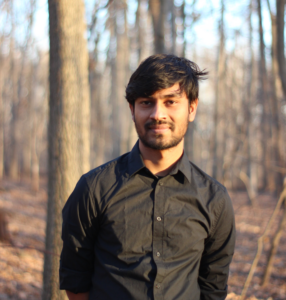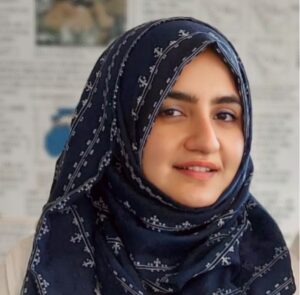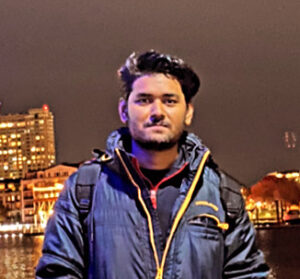Our 2022 event took place mid April on the 4th Floor of ITE.
PhD Student Research Awards
Rashidul Islam
 Title: Can We Obtain Fairness For Free?
Title: Can We Obtain Fairness For Free?
Abstract: There is growing awareness that AI and machine learning systems can in some cases learn to behave in unfair and discriminatory ways with harmful consequences. However, despite an enormous amount of research, techniques for ensuring AI fairness have yet to see widespread deployment in real systems. One of the main barriers is the conventional wisdom that fairness brings a cost in predictive performance metrics such as accuracy which could affect an organization’s bottom-line. In this paper we take a closer look at this concern. Clearly fairness/performance trade-offs exist, but are they inevitable? In contrast to the conventional wisdom, we find that it is frequently possible, indeed straightforward, to improve on a trained model’s fairness without sacrificing predictive performance. We systematically study the behavior of fair learning algorithms on a range of benchmark datasets, showing that it is possible to improve fairness to some degree with no loss (or even an improvement) in predictive performance via a sensible hyper-parameter selection strategy. Our results reveal a pathway toward increasing the deployment of fair AI methods, with potentially substantial positive real-world impacts.
Zahid Hasan
 Title: Ubiquitous Heart Rate Monitoring system via Remote Photoplethysmograph
Title: Ubiquitous Heart Rate Monitoring system via Remote Photoplethysmograph
Abstract: The primary contribution of this paper is designing and prototyping real-time edge computing system, RhythmEdge, that is capable of detecting changes in blood volume from facial videos (Remote Photoplethysmography; rPPG), enabling instantaneous cardiovascular health assessment. The benefits of RhythmEdge include non-invasive measurement of cardiovascular activity, real-time system operation, inexpensive sensing components, and computing. RhythmEdge captures a short video of the skin using a camera, extracts rPPG features to estimate the Photoplethysmography (PPG) signal using a multi-task learning framework while offloading the computing on the edge. In addition, we intelligently apply a transfer learning approach to the multi-task learning framework to mitigate sensor heterogeneities to scale the RhythmEdge prototype to work with a wider range of commercially available sensing and computing devices. Besides, to further adapt the software stack for resource-constrained devices, we postulate novel pruning and quantization techniques (Quantization: FP32, FP16; Pruned-Quantized: FP32, FP16), that efficiently optimizes the deep feature learning while minimizing the runtime, latency, memory, and power usage. Further, we benchmark RhythmEdge prototype for three different cameras and edge computing platforms while evaluating it on three publicly available datasets and an in-house dataset collected under challenging environmental circumstances. Our analysis indicates that RhythmEdge performs on par with the existing contactless heart rate monitoring systems while utilizing only half of its available resources. Furthermore, we performed an ablation study with and without pruning and quantization to report the model size (87%) vs. inference time (70%) reduction. We attested the efficacy of RhythmEdge prototype with a maximum power of $8W$ and a memory usage of 290MB, with a minimal latency of 0.0625 seconds and a runtime of 0.64 seconds per 30 frames.
PhD/Postdoc Completed Research Track
1st Place: Md Mahmudur Rahman
 Title: Multi-State Survival Analysis using Pseudo value-based Deep Neural Networks
Title: Multi-State Survival Analysis using Pseudo value-based Deep Neural Networks
Abstract: Multi-state survival analysis can provide insights about the complex disease progression in patients. A key challenge in multi-state survival analysis is the accurate subject-specific prediction of multi-state model quantities such as transition probability and state occupation probability in the presence of censoring. Traditional multi-state methods such as Aalen-Johansen (AJ) estimators and Cox-based methods are respectively limited by Markov and proportional hazards assumptions. Moreover, these approaches either do not use the covariates or make linearity assumptions which makes them infeasible for making subject-specific predictions. Recently proposed neural ordinary differential equations for multi-state survival analysis relax these assumptions but are computationally expensive and do not directly model the transition probabilities. To address these limitations, we propose novel pseudo-value based deep learning models for multi-state survival analysis, where we show that pseudo values – which efficiently handle censoring – can be a natural replacement for estimating the multi-state model quantities when derived from a consistent estimator. In particular, we derive pseudo values from AJ and landmark Aalen-Johansen (LMAJ) consistent estimators to directly predict the state occupation and transition probabilities using the subject’s covariates. Empirical results on synthetic and real-world datasets show that our proposed models achieve state-of-the-art results under various censoring settings.
2nd Place: Sahara Ali
 Title: SICNet – A Spatiotemporal Deep Neural Network for Forecasting Arctic Sea Ice
Title: SICNet – A Spatiotemporal Deep Neural Network for Forecasting Arctic Sea Ice
Abstract: Arctic amplification has altered the climate patterns both regionally and globally, resulting in more frequent and more intense extreme weather events in the past few decades. The essential part of Arctic amplification is the unprecedented sea ice loss as demonstrated by satellite observations. Accurately forecasting Arctic sea ice from sub-seasonal to seasonal scales has been a major scientific effort with fundamental challenges at play. Looking at the potential of data-driven approaches to study sea ice variations, we propose SICNet – a UNet-based based spatiotemporal deep learning model for forecasting Arctic sea ice concentration (SIC) at greater lead times. The model uses an encoder-decoder architecture with skip connections to regenerate spatial maps at future timesteps. Using monthly satellite retrieved sea ice data from NSIDC as well as atmospheric and oceanic variables from ERA5 reanalysis product during 1979-2021, we show that our proposed model provides promising predictive performance for per-pixel SIC forecasting at long lead times. This will substantially improve our ability in predicting future Arctic sea ice changes, which is fundamental for forecasting transportation routes, resource development, coastal erosion, threats to Arctic coastal communities and wildlife.
PhD/Postdoc Work-in-progress Research Track
1st Place: Sancharee Hom Chowdhury
 Title: Temporal Structure of Daily Paroxysmal Sympathetic Hyperactivity Assessment Measure (PSH-AM) among Neurocritical Patients with Traumatic Brain Injury
Title: Temporal Structure of Daily Paroxysmal Sympathetic Hyperactivity Assessment Measure (PSH-AM) among Neurocritical Patients with Traumatic Brain Injury
Abstract: Paroxysmal Sympathetic Hyperactivity (PSH) is the prototypical example of clinically relevant dysautonomia among neurocritical patients. It is characterized by an imbalance between sympathetic and parasympathetic nervous systems that is manifested by hypertension, tachycardia, hyperthermia, diaphoresis, and motor rigidity. PSH is observed in about one-third of Traumatic Brain Injury (TBI) patients and has been associated with poor outcomes. It is thus of clinical interest to monitor PSH symptoms for early detection and proactive treatment. In 2014, an expert panel developed a clinical assessment tool PSH-AM (Assessment Measure) as a quantitative measure for PSH diagnosis likelihood and symptom severity. While there have been studies using PSH-AM to understand PSH onset and frequency, there is little research to shed light on the day-by-day temporal variation of PSH and the feasibility of using vital signs to predict PSH-AM scores. Using the daily PSH-AM scores and the related component score and sub-scores calculated from 221 TBI patients from neurocritical units during the first 14 days since admission, our study sought to understand the multivariate temporal correlational structure of PSH-AM scores and assess the potential of developing systems to continuously track and predict PSH-AM scores.
2nd Place (tie): Xingyan Li
 Title: Deep Learning Single-Image Super Resolution for Bathymetry Data
Title: Deep Learning Single-Image Super Resolution for Bathymetry Data
Abstract: In the recent few years, remote sensing techniques on Earth’s surface, especially coastal areas, have provided important information for economic development and ecological restoration. Remote sensing images with higher resolution feature higher pixel density, and thus capture more details and are more beneficial for further analysis. However high-resolution images with no blur are not always available due to limitations on equipment, so researchers turn to deep-learning-based computer vision techniques to generate high resolution images from low resolution ones. We propose a bathymetry super resolution model to conduct single-image-super-resolution (SISR) on a global real-world remote sensing image with both width and height quadrupled. First we pretrain SR-ResNet with RGB images and train our new model on ICESAT-2 data set which containing single-banded raster graphics; second we make customized loss functions to focus the model on the coastal area; finally the results are evaluated using MSE, PSNR and SSIM. There are challenges in this project: (1) Most of the state-of-the-art super resolution models are designed on datasets containing natural pictures with RGB bands such as BSD100, BSDS300, BSDS500, CelebA, DIV2K, etc., while our images are remote-sensing images with raster bands. (2) We have to create customized loss functions to focus on the coastal area; (3) We have only limited data so transfer learning is used to train our model based on a pretrained model.
2nd Place (tie): Lydia Stamato
 Title: Exploring Experience through Bioart and HCI
Title: Exploring Experience through Bioart and HCI
Abstract: “Raaz ( راز “mystery” or “secret” in Farsi), is a multimedia bioart installation by Dr. Foad Hamidi and colleagues. Using synthetic biology and information theory, words of the 14th century Sufi poet Hafiz of Shiraz were inserted into the DNA of living yeast cells then used to ferment grape juice. This wine is at the center of the installation. A translation of the encoded stanza reads, “One whose heart is vitalized by Love never dies: Our continuity is written on the face of time.” The poem is further instantiated through a meditative recitation of the stanza with original bass flute melody, immersive light and sound design, and images of the genetically modified yeast. Each installation is impacted by characteristics of the space and featured an iteration on the installation design and artist talk. Three installations are being studied: 1) Baltimore Underground Science Space (Oct. 16, 2021), 2) Livewire 11: Rewired, UMBC Department of Music (Oct. 22-23, 2021), 3) UMBC Department of Information Systems (March 3-4, 2021). At each exhibition, we used participant observation to capture information about audience, artist, and researcher experience with a focus on audience interaction with, toward, and around the artwork; social interaction; and individual interpretation. We conducted interviews to explore audience reactions and opinions in more depth and surveys to understand personal and professional background. A goal of my analysis is to understand the meaning and impact of Raaz as a means of knowledge generation and exploration for human-computer interaction. Early analysis motivates investigating how installation art reveals information about the location, which can be used to inform future collaboration or intervention. We may investigate ”insider” and “outsider” roles and how art might affect these roles; opportunities for participatory meaning-making; and how bioart can be used to explore intangible phenomena and concepts, such as time.
MS/Undergraduate Completed Research Track
1st Place: Parth Thakkar
 Title: “It would probably turn into a social faux-pas”: Users’ and Bystanders’ Preferences of Privacy Awareness Mechanisms in Smart Homes
Title: “It would probably turn into a social faux-pas”: Users’ and Bystanders’ Preferences of Privacy Awareness Mechanisms in Smart Homes
Abstract: The opaque data practices in smart home devices have raised significant privacy concerns for smart home users and bystanders. One way to learn about the data practices is through privacy-related notifications. However, how to deliver these notifications to users and bystanders and increase their awareness of data practices is not clear. We surveyed 136 users and 123 bystanders to understand their preferences of receiving privacy-related notifications in smart homes. We further collected their responses to four mechanisms that improve privacy awareness (e.g., Data Dashboard) as well as their selections of mechanisms in four different scenarios (e.g., friend visiting ). Our results showed the pros and cons of each privacy awareness mechanism, e.g., Data Dashboard can help reduce bystanders’ dependence on users. We also found some unique benefits of each mechanism (e.g., Ambient Light could provide unobtrusive privacy awareness). We summarized four key design dimensions for future privacy awareness mechanisms design.
MS/Undergraduate Work-in-progress Research Track
1st Place: Govinda Sri Charan Duggirala
Title: Understanding Biophysiological Variations under Stress through Virtual Environments
 Abstract: Lifestyle of humans has changed a lot from what it used to look like 100 years ago. More people are getting into colleges and many are taking jobs and have larger social connections. Mental stress has become a part of our daily life and people today experience more stress due to work, school and other influences than ever before. Recent studies have shown stronger associations between high mental stress levels and unhealthy eating habits in young adults. Our study was done in a Virtual Reality environment where participants were induced mental stress through various tasks. We first had one round of basic tasks where we asked participants to make food selections of their choice and did not include any stressors to estimate their personalized baseline. In the second round we had one Go-NoGo stressor task and one public speaking task to induce mental stress and asked the participants to make food selections. The participants were not informed about any of these stressors before the study to avoid any possible biases. The main goal of the study was to observe their decision making process with respect to food selections under stress. Biophysical data such as heart rate variability and galvanic skin response were collected from participants during the study. They were the main indicators of emotional arousals and they showed certain trends when participants were in idle conditions and in stressed states. We observed an increase in skin conductance levels, elevated heart rates and decrease in heart rate variability measures. We then analyze the changes in biophysical data during each phase of the study to find relation between the decision making process in normal conditions vs in stressful situations.
Abstract: Lifestyle of humans has changed a lot from what it used to look like 100 years ago. More people are getting into colleges and many are taking jobs and have larger social connections. Mental stress has become a part of our daily life and people today experience more stress due to work, school and other influences than ever before. Recent studies have shown stronger associations between high mental stress levels and unhealthy eating habits in young adults. Our study was done in a Virtual Reality environment where participants were induced mental stress through various tasks. We first had one round of basic tasks where we asked participants to make food selections of their choice and did not include any stressors to estimate their personalized baseline. In the second round we had one Go-NoGo stressor task and one public speaking task to induce mental stress and asked the participants to make food selections. The participants were not informed about any of these stressors before the study to avoid any possible biases. The main goal of the study was to observe their decision making process with respect to food selections under stress. Biophysical data such as heart rate variability and galvanic skin response were collected from participants during the study. They were the main indicators of emotional arousals and they showed certain trends when participants were in idle conditions and in stressed states. We observed an increase in skin conductance levels, elevated heart rates and decrease in heart rate variability measures. We then analyze the changes in biophysical data during each phase of the study to find relation between the decision making process in normal conditions vs in stressful situations.
2nd Place: Rohan Salvi
Title: Nowcasting PSH-AM: Towards Real-time Assessment of Paroxysmal Sympathetic Hyperactivity using Continuous Vital Sign Measurements in Neurocritical Units
 Abstract: Paroxysmal Sympathetic Hyperactivity (PSH) refers to a clinical syndrome manifested by paroxysmal episodes of sympathetic activity often observed in patients with severe acute brain injury, notably, those with Traumatic Brain Injury (TBI). Untreated PSH has been associated with poor outcomes. It is thus desirable to be able to continuously monitor PSH symptoms for early detection and proactive treatment. However, it is not feasible in practice due to the lack of reliable quantitative detection and monitoring tools. PSH-AM2 scoring system is a consensus-based assessment tool for diagnosis likelihood and symptom severity. However, its widespread adoption has met with obstacles in practice due to its inefficient manual information gathering process, and its accuracy is further threatened by incomplete documentation. In this research, we plan to explore a machine learning based framework to “”nowcast”” PSH-AM, i.e. automatically compute the scores using the continuous vital sign signals collected from bedside monitors.
Abstract: Paroxysmal Sympathetic Hyperactivity (PSH) refers to a clinical syndrome manifested by paroxysmal episodes of sympathetic activity often observed in patients with severe acute brain injury, notably, those with Traumatic Brain Injury (TBI). Untreated PSH has been associated with poor outcomes. It is thus desirable to be able to continuously monitor PSH symptoms for early detection and proactive treatment. However, it is not feasible in practice due to the lack of reliable quantitative detection and monitoring tools. PSH-AM2 scoring system is a consensus-based assessment tool for diagnosis likelihood and symptom severity. However, its widespread adoption has met with obstacles in practice due to its inefficient manual information gathering process, and its accuracy is further threatened by incomplete documentation. In this research, we plan to explore a machine learning based framework to “”nowcast”” PSH-AM, i.e. automatically compute the scores using the continuous vital sign signals collected from bedside monitors.
Audience Choice Awards
Completed Research Track
1st Place: Redwan Walid
 Title: Secure Cloud EHR with Semantic Access Control, Searchable Encryption and Attribute Revocation
Title: Secure Cloud EHR with Semantic Access Control, Searchable Encryption and Attribute Revocation
Abstract: To ensure a secure Cloud-based Electronic Health Record (EHR) system, we need to encrypt data and impose field-level access control to prevent malicious usage. Since the attributes of the Users will change with time, the encryption policies adopted may also vary. For large EHR systems, it is often necessary to search through the encrypted data in real- time and perform client-side computations without decrypting all patient records. This paper describes our novel cloud-based EHR system that uses Attribute Based Encryption (ABE) combined with Semantic Web technologies to facilitate differential access to an EHR, thereby ensuring only Users with valid attributes can access a particular field of the EHR. The system also includes searchable encryption using keyword index and search trapdoor, which allows querying EHR fields without decrypting the entire patient record. The attribute revocation feature is efficiently managed in our EHR by delegating the revision of the secret key and ciphertext to the Cloud Service Provider (CSP). Our methodology incorporates advanced security features that eliminate malicious use of EHR data and contributes significantly towards ensuring secure digital health systems on the Cloud.
Work-in-progress Research Track
1st Place: Emon Dey
 Title: Decentralized multi-master ROS system for communication between UAVs and UGVs
Title: Decentralized multi-master ROS system for communication between UAVs and UGVs
Abstract: With the advancement of modern robotics, autonomous agents are now capable of hosting sophisticated algorithms, which enables them to make intelligent decisions. But developing and testing such algorithms directly in real-world systems is tedious and may result in the wastage of valuable resources. Specifically, for heterogeneous multi-agent systems in battlefield environments where communication is critical in determining the system’s behavior and usability. In this work, we plan to build an efficient decentralized multi-master ROS system to help improve the synchronized communications between heterogeneous aerial and ground vehicles. Due to the necessity of simulators of separate paradigms (co-simulation) to simulate such scenarios before deployment, synchronization between those simulators is vital. Existing works aimed at resolving this issue fall short of addressing diversity among deployed agents. To resolve this issue, we propose an integrated co-simulation middleware to simulate a heterogeneous multi-robot system. Here, a velocity difference-driven adjustable window size approach is introduced with a view to reducing packet loss probability. It takes into account the respective velocities of deployed agents to calculate a suitable window size before transmitting data between them. We validate our approach empirically at both the simulation and system level for both line-of-sight (LOS) and non-line-of-sight (NLOS) scenarios. Our approach achieves a noticeable improvement in terms of reducing packet loss probability (11%), and average packet delay (10%) compared to the fixed window size-based synchronization approach. As a follow-up to this work, we plan to look at some other issues, such as how sensitive communication is in complex terrain and how the rate of transmission slows down in NLOS communication.